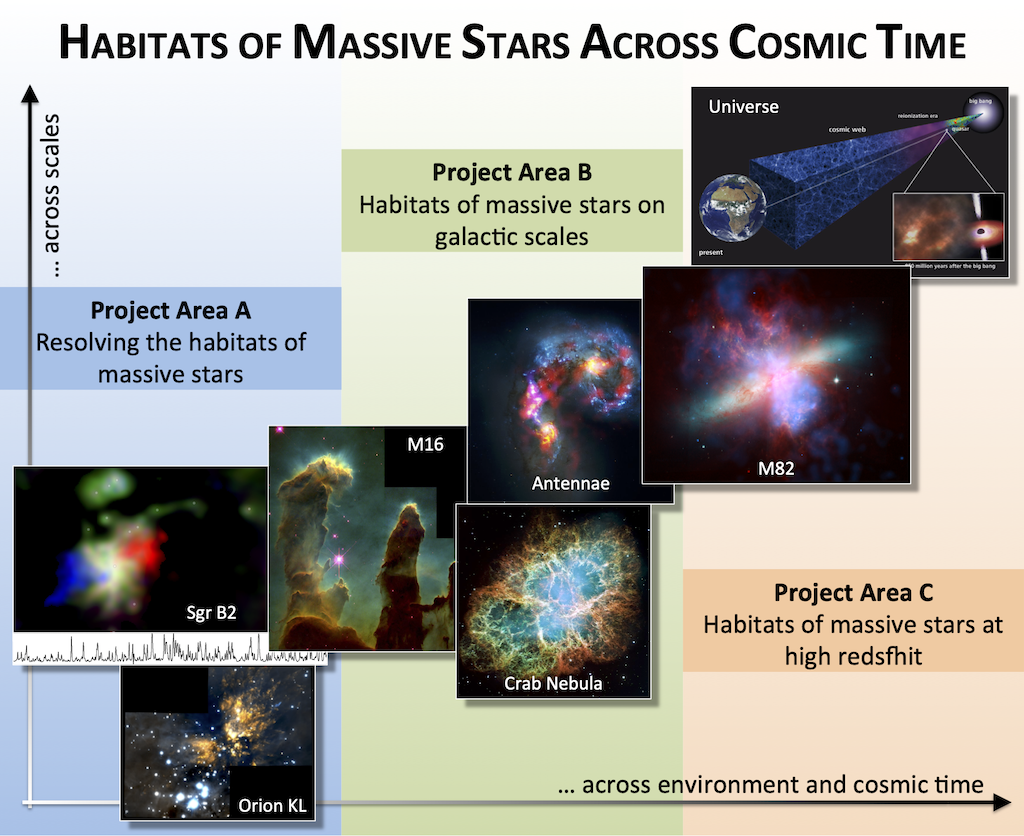CRC/SFB 1601 - Habitats of massive stars across cosmic times

Massive stars, due to their short lifetime and high energy output, drive the evolution of galaxies across cosmic time. Hence, they substantially contribute to shaping the present-day Universe. The proposed new Collaborative Research Centre (CRC) will unravel the “habitats of massive stars across cosmic time”. “Habitats” are the gaseous environments within which massive stars are born and which they interact with via their feedback. Over the anticipated 12-year lifetime of this new CRC initiative, we aim to connect the physical processes that govern the habitats of massive stars across the full range of environments hosting massive stars – from sub-parsec to mega-parsec scales and from the Milky Way to the high-redshift Universe, where massive stars leave their cosmological fingerprint by driving cosmic reionisation.
We have identified two major gaps in our current understanding, which this CRC will close: the “spatial scale gap”, which provides the missing link between the small (sub-parsec) scale studies and Galactic scale studies of high-mass star habitats; and the “environment gap”, extrapolating the physics of star formation, which can be examined in detail in the well-studied star formation sites in the Milky Way and the Magellanic Clouds, to the extreme environments prevailing at high redshift. These gaps are naturally connected as the most extreme environments are rare and distant and hence suffer from coarse resolution when observed from Earth. Both gaps are difficult to overcome due to the interconnected nature of the physical processes acting on all scales and hence they are the subject of intense research in the international astronomical community. Bridging these gaps calls for a large-scale collaborative effort, as enabled by this CRC.
In the proposed CRC, which assembles a selected team of highly qualified experts, we will join forces to closely collaborate on the study of high-mass star formation at high resolution (project area A), massive star formation and signatures of high-mass star feedback on galactic scales (project area B), and the imprints of high-mass star formation on high-redshift galaxies and cosmic reionisation (project area C). We choose a unique and holistic approach, interweaving four pillars of expertise: (Pillar 1) laboratory astrophysics, (Pillar 2) instrumentation development, (Pillar 3) observations and (Pillar 4) theoretical modelling and simulations. Although each of these disciplines stands out in its own right, it is their combination that makes the CRC unique and sets the stage for breakthrough discoveries. Thus, the collaborative effort of this CRC is well prepared to close the two open gaps.
The CRC partners have developed a strong profile as scientific leaders in the research field of their respective pillars of expertise. For decades, this has enabled our leadership role in large international observing programmes. Additionally, the Cologne and Bonn institutes have ample experience in building, running, and maintaining their own telescopes and developing cutting-edge instrumentation at infrared to submillimetre and radio wavelengths. Several new and upcoming developments will put this CRC in a prime position to become a well-known international centre.
In particular, the start of the novel FYST/CCAT telescope in 2024, in which the universities of Cologne and Bonn are partners with a 25% share, will provide the necessary large-area surveys and a platform for instrument development over the coming decade. ALMA will be sufficiently upgraded and MeerKAT will transition to the SKA on the timescale of this CRC, providing substantial complementary resources to our own observatory.
With respect to super-computing, we are entering an era of exascale computing, with the first such system in Europe to be installed at Forschungszentrum Jülich in 2024. Overall, with its broad scientific expertise, this topical CRC will offer an inspiring research environment for the next generation of students.
With the wealth of upcoming observational data on the habitats of massive stars across cosmic time to which our team has preferred access, the opportunity to launch a new CRC in 2023 is uniquely timely. It will allow us to establish an internationally visible centre on “The Habitats of Massive Stars”.
Sub-Project area A6 - Tracing star formation through observations of UV-chemistry

Project A6 plans to improve our understanding of the physics of photon-dominated regions (PDRs), this means interstellar clouds where the UV radiation from young massive stars creates a characteristic chemistry and excitation in the medium. Based on models we will try to derive the properties of the usually deeply embedded young stars from the observable radiative signatures at infrared and radio wavelengths. Understanding the PDR physics allows us to interpret the observations of the main cooling and additional diagnostics lines as a tool to measure the impinging UV field produced by short-living O- and B-type stars.
Major questions to be solved are the role and distribution of PAHs and very small dust grains and the details of the H2 formation and excitation in the ISM. For both aspects we expect revolutionising new observational constraints from JWST spectroscopy. At the same time a better understanding of the dust physics in PDRs is a prerequisite to interpret the spatially unresolved observations of PDR tracers at high redshifts.
Based on the long-term experience in Cologne with clumpy PDR modelling, we plan to implement a versatile framework to fit observations of any highly complex UV-dominated structure by clump ensembles using the KOSMA-tau-3D approach. A major work package covering the whole CRC time frame is the development of efficient and specific tools for the comparison of the large observational data sets, with the model predictions taking the full set of lines and continuum data, the spatial structure, and the velocity profiles into account.
By answering the PDR-specific question: Which observational signatures, which lines and chemical tracers are reliable measures of the local UV radiation across different galaxies and cosmic times? we provide tools so that CRC 1601 can address the question: How can we actually measure the star-formation rate across the universe?
